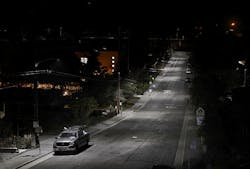GE Lighting has announced that the city of Oakland, California is in the process of retrofitting 30,000 street lights with GE Evolve LED Roadway Scalable Cobrahead fixtures. The city is converting high-pressure sodium (HPS) lights that range from 70–400W along the breadth of the city's roadways with the GE product family that offers models that can deliver a variety of lumen packages, as the scalable name implies.
Related article: GE expands options in energy-efficient Evolve LED scalable area lights
AFTER: Oakland street lighting with GE Evolve LED Roadway Scalable Cobrahead fixtures.
GE first launched the GE Evolve LED Roadway Scalable Cobrahead fixture family in mid-2012. The design allows for variation in lumen output within the LED light engine used in the luminaires and the ability to combine from one to four light engines in a single luminaire. Indeed, the family can deliver 3000 to more than 20,000 lm. That scalability means that Oakland can use the same product family for residential streets as well as major roadways.
Indeed, the scalability played a major role in distributor Graybar recommending the GE products to the city. "Because the Evolve fixture offers tremendous scalability and flexibility, we could easily tailor the solution to meet Oakland’s requirements," said Kristian Reyes, manager of the lighting business at Graybar. "After identifying Oakland’s needs, we decided the GE Evolve fixture would best suit this project."
The city of Oakland is projecting that the solid-state lighting (SSL) retrofit will deliver 40% baseline energy savings relative to the HPS lighting. And the initial maintenance savings will come via the inherent longer life of the LED-based fixtures.
"The program again proves that Oakland is a national leader in civic innovation, saving money and helping to protect the environment," said Oakland Mayor Jean Quan. "These lights burn less energy, which means we're reducing our energy bills and our energy use at the same time, and their much longer lifespan also means we're reducing our e-waste footprint. Everyone who has contributed to this project is helping Oaklanders and making our city proud."
Still, the savings, both in the area of maintenance and energy, could be enhanced down the road through adaptive controls and a network. Graybar recommended a controls-ready luminaire and the city could add support for a network in the futures. Such an upgrade could enable dimming the lights during low-traffic periods to further slash energy use and automation of maintenance tasks.
Indeed, GE began actively promoting an outdoor lighting network technology at Lightfair International last year. The GE LightGrid technology is being trialed in the city of Los Angeles and combines a wireless network and the use of GPS receivers on light poles to quickly identify the location of failed lights.






